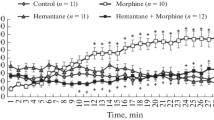Abstract
Rats received daily i.p. injections of p-chlorophenylalanine (PCPA) for 3 days, before morphine and related drugs were implanted into the lateral thalamus or injected systemically. PCPA enhanced the stereotyped response to morphine, methadone, and apomorphine, as expressed by compulsive gnawing, but abolished the antagonistic effect of large doses of i.p. morphine. Thus, suppression of gnawing by large doses of systemic morphine and related analgesics may be mediated by a serotoninergic pathway. PCPA also brought to light the ability of pethidine to cause gnawing, which is otherwise suppressed by the strong antagonistic effect of this drug.
Morphine and related analgesic drags exert a dual effect: stimulation of gnawing via a catecholaminergic mechanism and inhibition of gnawing by a serotoninergic mechanism.
Similar content being viewed by others
References
Bergmann, F., Chaimovitz, M., Pasternak (Na'or), V., Ramu, A.: Compulsive gnawing in rats after implantation of drugs into the ventral thalamus. A contribution to the mechanism of morphine action. Brit. J. Pharmacol. 51, 197–205 (1974)
Buxbaum, D. M., Yarbrough, G. G., Carter, M. E.: Biogenic amines and narcotic effects. I. Modification of morphineinduced analgesia and motor activity after alteration of cerebral amine levels. J. Pharmacol. exp. Ther. 185, 317–327 (1973)
Fog, R.: Behavioral effects in rats of morphine and amphetamine and of a combination of the two drugs. Psychopharmacologia (Bed.) 16, 305–312 (1970)
Haubrich, D. R., Blake, D. E.: Modification of the hypothermic action of morphine after depletion of brain serotonin and catecholamines. Life Sci. 10, 175–180 (1971)
Haubrich, D. R., Perez-Cruet, J., Reid, W. D.: Prostaglandin E1 causes sedation and increases 5-hydroxytryptamine turnover in rat brain. Brit. J. Pharmacol. 48, 80–87 (1973)
Koe, B. K., Weissman, A.: p-Chlorophenylalanine: A specific depletor of brain serotonin. J. Pharmacol. exp. Ther. 154, 499–516 (1966)
Major, C. T., Pleuvry, B. J.: Effects of α-methyl-p-tyrosine, p-chlorophenylalanine, l-Β-(3,4-dihydroxyphenyl)alanine, 5-hydroxytryptophan and diethyldithiocarbamate on the analgesic activity of morphine and methylamphetamine in the mouse. Brit. J. Pharmacol. 42, 512–521 (1971)
Sheard, M. H.: The effect of p-chlorophenylalanine on behavior in rats: relation to brain serotonin and 5-hydroxyindoleacetic acid. Brain Res. 15, 524–528 (1969)
Shillito, E. E.: The effect of parachlorophenylalanine on social interaction of male rats. Brit. J. Pharmacol. 38, 305–315 (1970)
Spencer, P. S. J., Turner, T. A. R.: Blockade of biogenic amine synthesis: its effect on the responses to leptazol and dexamphetamine in rats. Brit. J. Pharmacol. 37, 94–103 (1969)
Tenen, S. S.: The effect of p-chlorophenylalanine, a serotonin depletor, on avoidance acquisition, pain sensitivity and related behavior in the rat. Psychopharmacologia (Berl.) 10, 204–219 (1967)
Tenen, S. S.: Antagonism of the analgesic effect of morphine and other drugs by p-chlorophenylalanine, a serotonin depletor. Psychopharmacologia (Berl.) 12, 278–285 (1968)
Author information
Authors and Affiliations
Rights and permissions
About this article
Cite this article
Bergmann, F., Chaimovitz, M. & Pasternak, V. Dual action of morphine and related drugs on compulsive gnawing of rats. Psychopharmacologia 46, 87–91 (1976). https://doi.org/10.1007/BF00421554
Received:
Revised:
Issue Date:
DOI: https://doi.org/10.1007/BF00421554




